
Since I was little, I’ve often been asked about the origin of my Illidi surname. Whenever I asked my dad, he would respond with the same line: “It’s a made-up name because my bisnonno [great grandfather] was adopted.” As a child, I accepted this as the full story: I had an ancestor with unknown parents and my surname was made up. However, as an adult, my curiosity grew. Modern DNA technology enables us to discover long-lost relatives, and archives are increasingly digitizing their collections for global access. With the time and opportunity to explore, I set out to uncover my Illidi history. Specifically, I set out to discover the origins of the first Illidi, and my great-great-grandfather, Ghilardo Illidi (1880-1960).
Starting the Search: So Many Questions and Rumors
I began my search by interviewing older relatives, only to discover a tapestry of conflicting stories. One tale told of a baby abandoned on a doorstep, while another jumped straight to his childhood, suggesting he grew up with his biological father or uncle without knowing. More specifically, I heard hints that a biological relative, likely an uncle, had taken Ghilardo in as an official foster child, perhaps motivated by the financial incentives of the Italian foster system at the time.
Yet, I was surprised to learn that there were no stories about his mother. The only memory shared was that she hailed from Montefegatesi, a neighbouring village. It was striking that none of those sharing their versions had ever thought of asking Ghilardo about his origins or what he had known about his own parentage. Notably, however, my own nonno (Ghilardo’s grandson) recalled Ghilardo sharing that he grew up with a Lucchesi family in Cembroni in San Cassiano, even naming the three brothers—Giovanni, Tamante, and Armando Lucchesi—who lived with him.
Photo: Ghilardo Illidi and Argenta (Argentina) Talenti, around the time of their marriage in 1906.
With these rumours swirling in my mind, I dove into birth and marriage records, searching for clues in the long list of civil records available from the area around 1900. A key piece of evidence emerged from their 1906 marriage record1, which noted that Ghilardo Illidi was born in Lucca, listed as having ‘padre ignoto’ and ‘madre ignota’—unknown parents. This raised a crucial question: was Lucca referring to the city or the province? Either way, I knew my search would be like looking for a needle in a haystack.
Photo: The marriage record of Ghilardo Illidi, named Gherardo, and Argenta (Argentina) Talenti on March 16th 1906. Ghilardo’s parents are listed as unknown1.
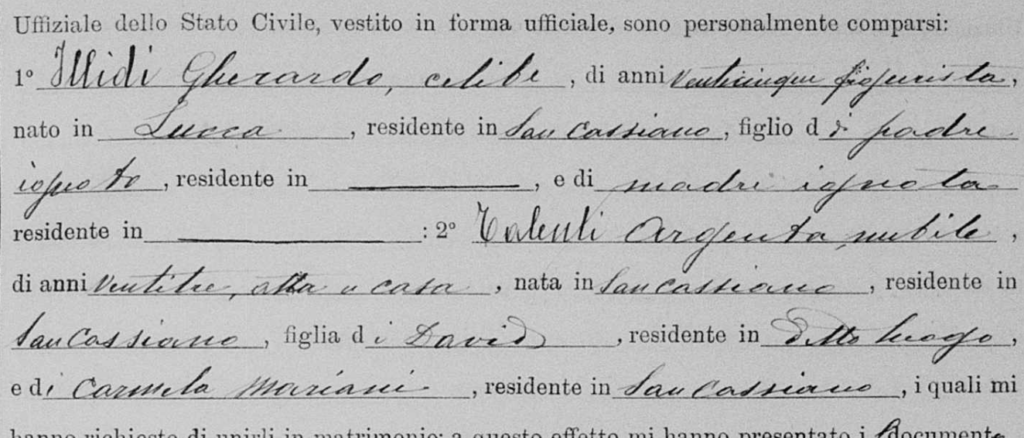
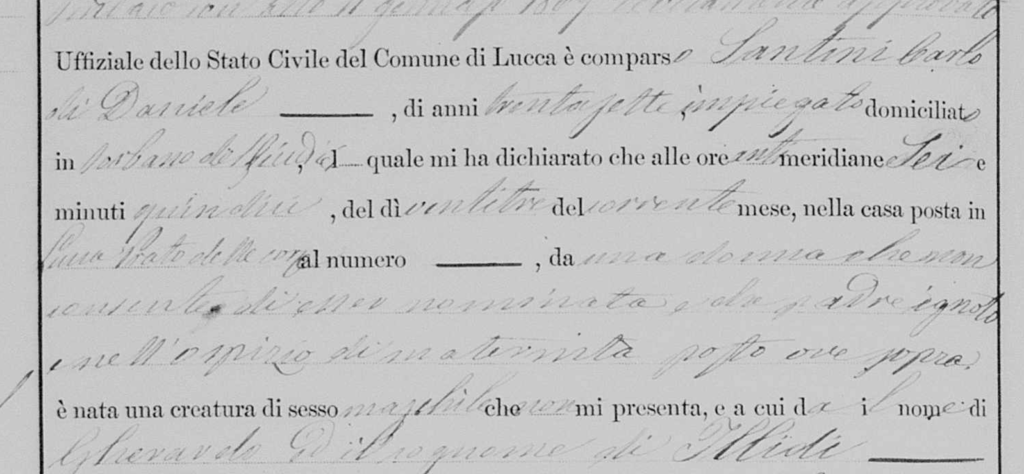
Finding the Birth Record
To my surprise, locating Ghilardo’s birth record was easier than I had feared. I accessed the birth register from the city of Lucca and found his registration dated April 23rd, 18802, matching his marriage record with Argentina from 1906 perfectly. The record revealed he was born at the maternity hospital of Lucca to an unnamed mother and an unknown father. While this wasn’t the breakthrough I had hoped for, I reminded myself of the social stigma surrounding illegitimate children in the late 1800s Catholic Italian countryside.
But I wasn’t finished yet. Children born out of wedlock had additional documentation, detailing their circumstances and care arrangements (e.g., an assigned wet nurse, foster care, or adoption). I quickly searched for the attachments concerning children born around the same time but found no mention of Ghilardo. What did this mean?
Photo: The birth record of Ghilardo, originally Gherardo, Illidi on April 23rd 1880 in the city of Lucca. The mother did not want to be named while the father was reported as unknown2.
As I spent countless afternoons sifting through online archives, I also awaited the DNA results of my grandfather, a grandson of Ghilardo through Ghilardo’s son, Ezio (1911-1999). Earlier that year, I had ordered an autosomal DNA test with MyHeritage, hoping to find interesting genetic clues in my grandfather’s DNA as well as in long-lost relatives who shared genetic material or DNA via common ancestors (called ‘DNA matches’).
Before the results arrived, however, I had traced my grandfather’s other ancestral lines back in time. To my delight, I discovered that his maternal grandparents, Maria Marta Bastiani and Luigi Giannini, could be traced back to San Cassiano as early as the 1600s. So could the ancestry of Ghilardo’s wife, Argentina. This was promising; in the close-knit community of San Cassiano, DNA analyses could reveal outliers—matches and ancestors who didn’t belong in San Cassiano. In other words, if Ghilardo’s parents were from other villages or towns, this would be evident in the DNA analysis.
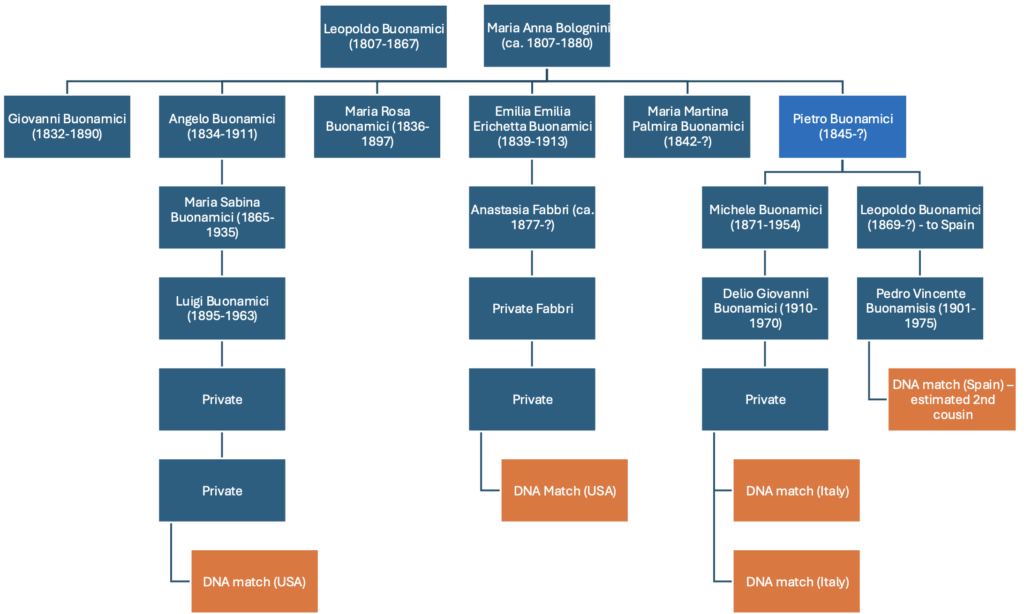
We Have the DNA Results—And 7000 Matches!
I’ll spare you the tedious details of the eight months I spent analyzing thousands of DNA matches. Through meticulous work, I linked nearly all my grandfather’s closest DNA matches—fourth cousins and closer—to his San Cassiano ancestors. They were descendants of the Fabbri, Giannini, Lucchesi, and Mariani families, now scattered across Italy, Switzerland, Norway, Sweden, the United States, Brazil, and Argentina. However, one match stood out: a woman in Spain, genetically my grandfather’s second cousin with a shared great-grandparent to my grandfather (i.e., a potential parent of Ghilardo).
Utilizing a technique called genetic clustering, I identified the unique DNA segments shared between my grandfather and the Spanish woman. In addition, I identified four other DNA testers who shared these unique segments. It turned out that my grandfather was part of a very small cluster of five descendants of a very specific Buonamici family! In fact, the ancestry of these five individuals could be traced back to one Leopoldo Buonamici (1807-1867; see Buonamici descendency graph to the left, with DNA matches in orange). This man and his family had roots in Montecatini Terme, Pistoia but moved to San Cassiano in the 1860s before they settled in San Cassiano, Pieve di Controne or emigrated to Spain and the US. This unexpected connection hinted at a significant familial link.
The Research Continues: Now with a FAN Club
As I was navigating through thousands of DNA matches, I made an important realization: aside from the Buonamici family, there were no other matches pointing to Ghilardo’s potential origin in Lucca. I also identified DNA testers with roots in Montefegatesi but with no shared DNA, leading me to believe that both of Ghilardo’s biological parents must have had strong connections to San Cassiano. With each new DNA test from Ghilardo’s descendants, the puzzle became clearer.
Feeling confident in my progress, I embarked on what’s known as FAN club research—investigating friends, associates, and neighbors to unveil hidden patterns in family dynamics. In the Italian context, this includes understanding neighbourhood dynamics, labour arrangements, and connections through civil records.
I quickly identified that Ghilardo’s closest friends and acquaintances were Lucchesi family members from Cembroni. Declarants at his children’s births were Lucchesi brothers, and during Ghilardo’s marriage to Argentina in 1906, another Lucchesi cousin (Romualdo Lucchesi) served as a witness2. Even more telling, Ghilardo’s son, Primo Illidi, declared the deaths of a close Lucchesi family member in the 1930s3. But then, a new analysis technique became available – and I got some of the answers I had been looking for!
Photo: Ghilardo Illidi and Argenta (Argentina) Talenti, likely in the 1940s.
Sources:
1 Civil record, marriages (Mar 1906): Bagni di Lucca, Toscana, Italy (Gherardo Illidi & Argenta Talenti), p. 248, reference #646: https://www.familysearch.org/ark:/61903/3:1:3QSQ-G9W7-5DV7?i=247&cat=836067
2 Civil record, births (Apr 1880): Lucca, Toscana, Italy (Gherardo Illidi), p.1834, reference #22: https://www.familysearch.org/ark:/61903/3:1:3QS7-89WQ-5D49?i=1833&cc=2043811&cat=721079
3 Civil record, deaths (Jul 1930): Bagni di Lucca, Toscana, Italy (Riccardo Barsellotti), page 39, reference #74: https://www.familysearch.org/ark:/61903/3:1:3Q9M-CSM8-HLM9?view=explore&groupId=TH-909-54338-18894-65
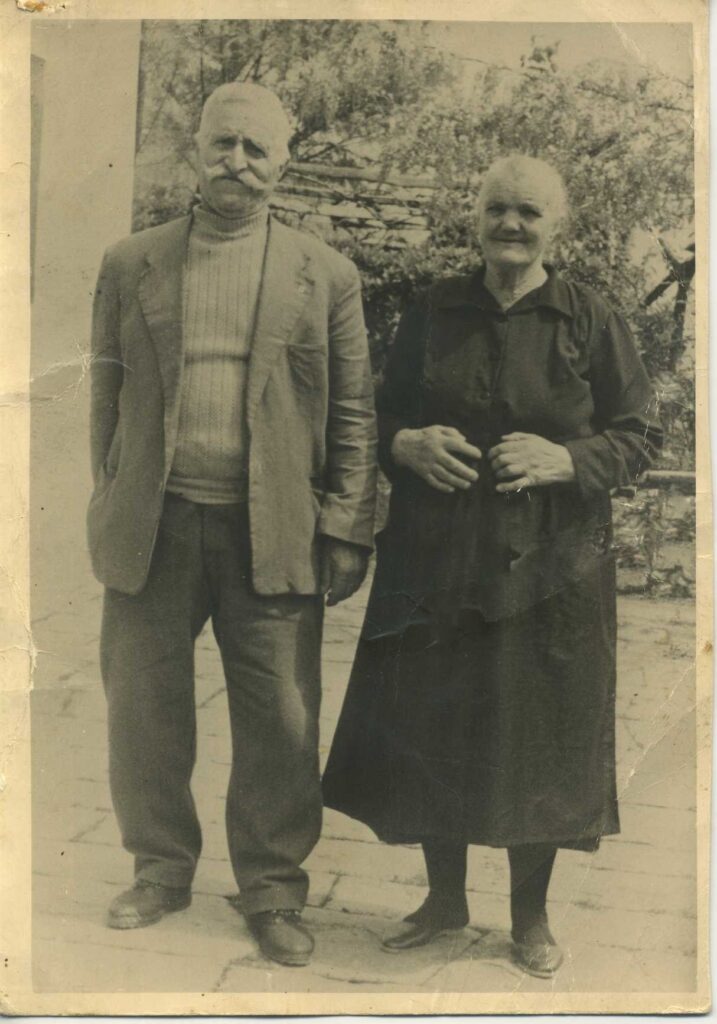
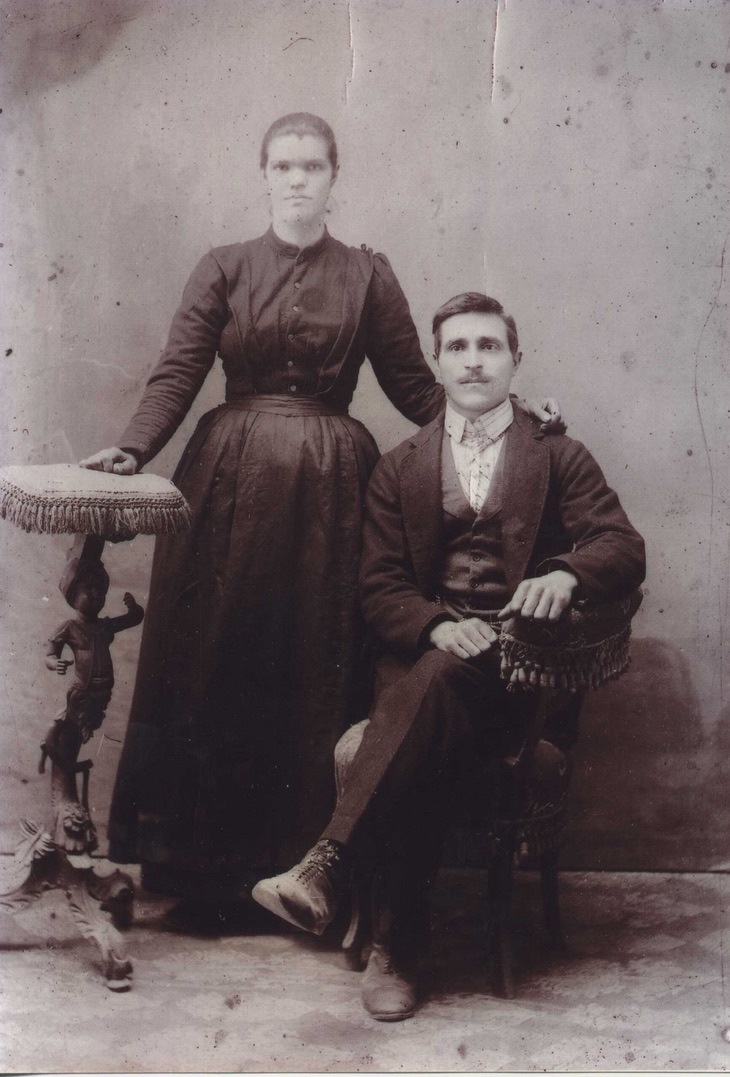
Leave a Reply